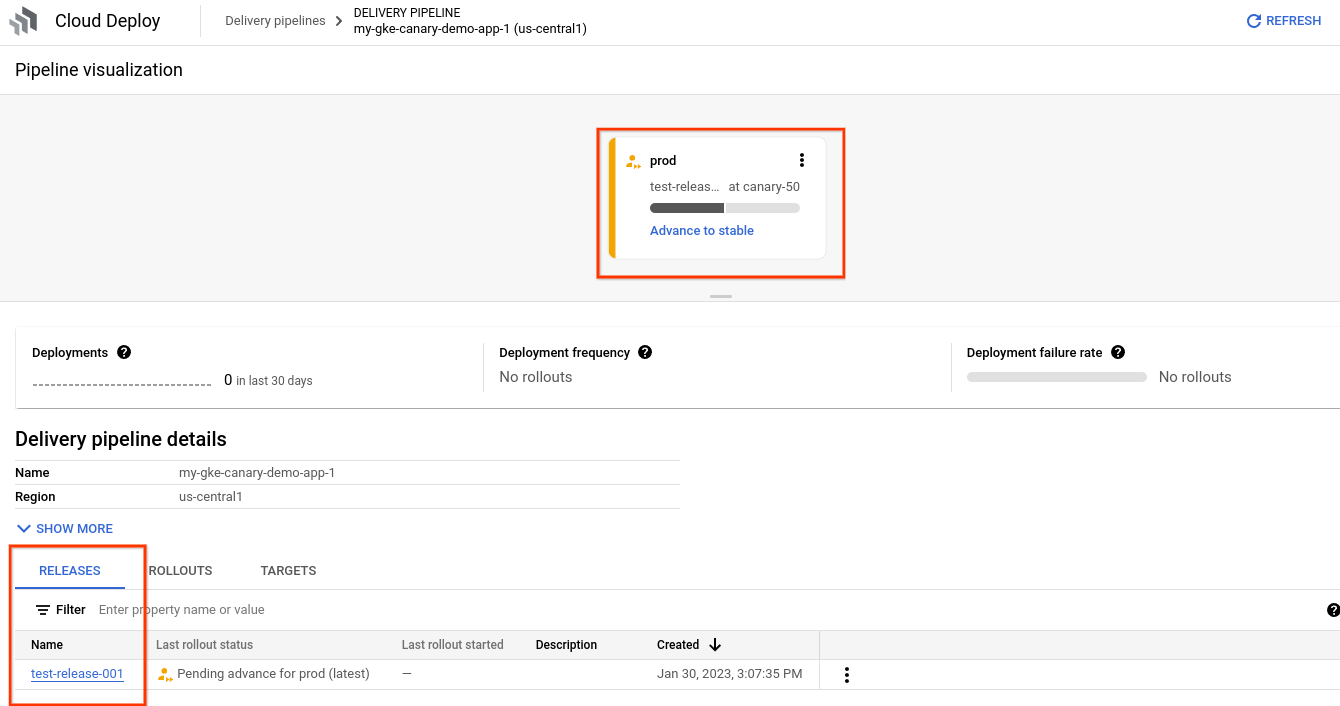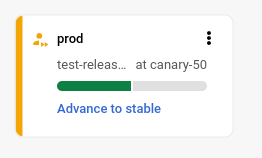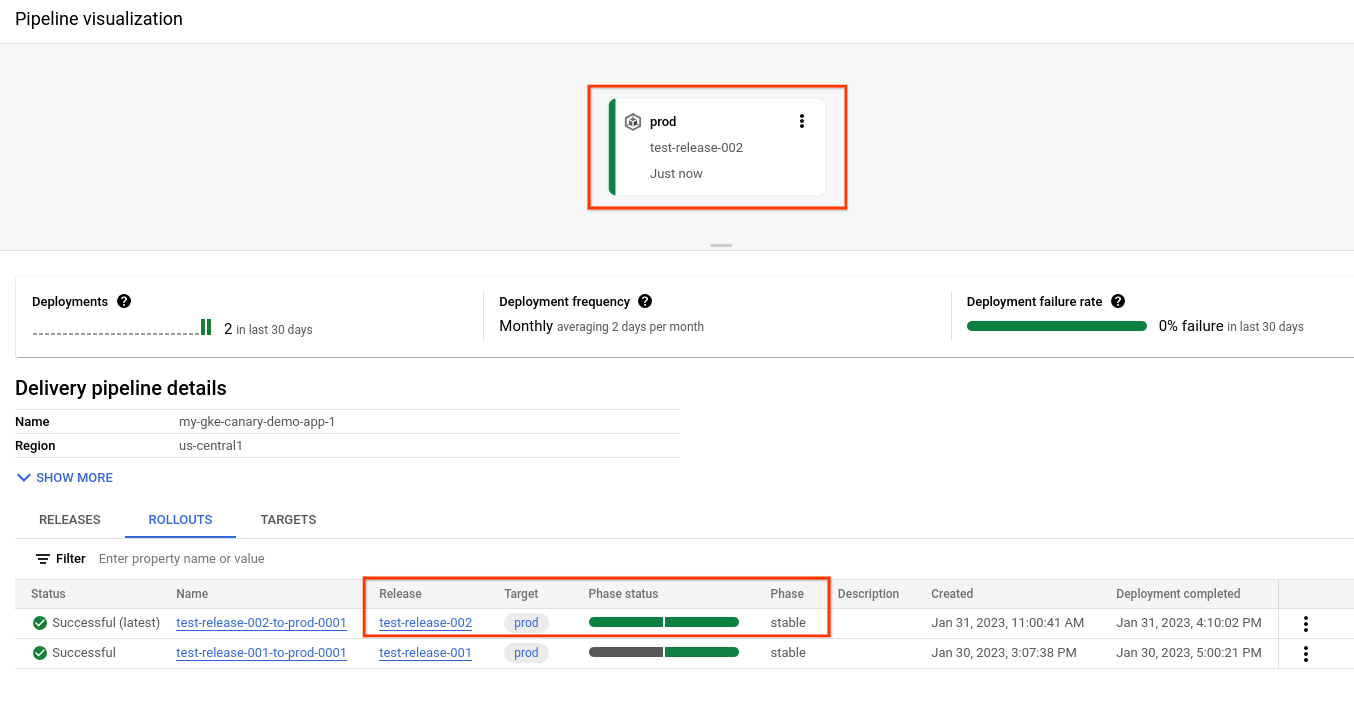Canary-deploy an application to a target
This quickstart shows you how to use Cloud Deploy to deliver a sample application image in a canary deployment to either Google Kubernetes Engine or to Cloud Run. (You can also run a canary deployment to GKE Enterprise, but only GKE and Cloud Run are shown in this quickstart.)
A canary deployment splits traffic between an already-deployed version of the application and the new version. Cloud Run apportions traffic based on the percentages you configure in the delivery pipeline. GKE deploys the new version to a proportion of pods. This quickstart deploys to 50% first, then to 100%.
In this quickstart, there is only one target,
(prod).
So we create only one GKE cluster or one
Cloud Run service to run your application.
In this quickstart, you'll do the following:
Create one GKE cluster or define one Cloud Run service.
You can canary deploy to GKE Enterprise clusters too, but this quickstart uses GKE and Cloud Run only.
Create a Skaffold configuration and a Kubernetes manifest to specify the (pre-built) container image to deploy.
Define your Cloud Deploy delivery pipeline and deployment target.
Invoke your delivery pipeline by creating a release, which automatically deploys to one target.
This first release skips the canary phase.
View the delivery pipeline and release in the Google Cloud console.
Create a second release, this time executing the canary stage to deploy the application to 50%.
Advance the release to deploy to 100%.
Before you begin
- Sign in to your Google Cloud account. If you're new to Google Cloud, create an account to evaluate how our products perform in real-world scenarios. New customers also get $300 in free credits to run, test, and deploy workloads.
-
In the Google Cloud console, on the project selector page, select or create a Google Cloud project.
Roles required to select or create a project
- Select a project: Selecting a project doesn't require a specific IAM role—you can select any project that you've been granted a role on.
-
Create a project: To create a project, you need the Project Creator
(
roles/resourcemanager.projectCreator), which contains theresourcemanager.projects.createpermission. Learn how to grant roles.
-
Verify that billing is enabled for your Google Cloud project.
-
Enable the Cloud Deploy, Cloud Build, GKE, Cloud Run, and Cloud Storage APIs.
Roles required to enable APIs
To enable APIs, you need the Service Usage Admin IAM role (
roles/serviceusage.serviceUsageAdmin), which contains theserviceusage.services.enablepermission. Learn how to grant roles. -
Install the Google Cloud CLI.
-
If you're using an external identity provider (IdP), you must first sign in to the gcloud CLI with your federated identity.
-
To initialize the gcloud CLI, run the following command:
gcloud init -
In the Google Cloud console, on the project selector page, select or create a Google Cloud project.
Roles required to select or create a project
- Select a project: Selecting a project doesn't require a specific IAM role—you can select any project that you've been granted a role on.
-
Create a project: To create a project, you need the Project Creator
(
roles/resourcemanager.projectCreator), which contains theresourcemanager.projects.createpermission. Learn how to grant roles.
-
Verify that billing is enabled for your Google Cloud project.
-
Enable the Cloud Deploy, Cloud Build, GKE, Cloud Run, and Cloud Storage APIs.
Roles required to enable APIs
To enable APIs, you need the Service Usage Admin IAM role (
roles/serviceusage.serviceUsageAdmin), which contains theserviceusage.services.enablepermission. Learn how to grant roles. -
Install the Google Cloud CLI.
-
If you're using an external identity provider (IdP), you must first sign in to the gcloud CLI with your federated identity.
-
To initialize the gcloud CLI, run the following command:
gcloud init - Make sure the default Compute Engine service account has sufficient permissions.
The service account might already have the necessary permissions. These steps are included for projects that disable automatic role grants for default service accounts.
- First add the
clouddeploy.jobRunnerrole:gcloud projects add-iam-policy-binding PROJECT_ID \ --member=serviceAccount:$(gcloud projects describe PROJECT_ID \ --format="value(projectNumber)")-compute@developer.gserviceaccount.com \ --role="roles/clouddeploy.jobRunner" - Add the developer role for your specific runtime.
- For GKE, and GKE with Gateway API:
gcloud projects add-iam-policy-binding PROJECT_ID \ --member=serviceAccount:$(gcloud projects describe PROJECT_ID \ --format="value(projectNumber)")-compute@developer.gserviceaccount.com \ --role="roles/container.developer" - For Cloud Run:
gcloud projects add-iam-policy-binding PROJECT_ID \ --member=serviceAccount:$(gcloud projects describe PROJECT_ID \ --format="value(projectNumber)")-compute@developer.gserviceaccount.com \ --role="roles/run.developer" -
Add the
iam.serviceAccountUserrole, which includes theactAspermission to deploy to the runtime:gcloud iam service-accounts add-iam-policy-binding $(gcloud projects describe PROJECT_ID \ --format="value(projectNumber)")-compute@developer.gserviceaccount.com \ --member=serviceAccount:$(gcloud projects describe PROJECT_ID \ --format="value(projectNumber)")-compute@developer.gserviceaccount.com \ --role="roles/iam.serviceAccountUser" \ --project=PROJECT_ID
- First add the
If you already have the CLI installed, make sure you're running the latest version:
gcloud components update
Create your runtime environment
GKE
Create one GKE Autopilot cluster:
gcloud container clusters create-auto canary-quickstart-cluster \
--project=PROJECT_ID \
--region=us-central1
GKE + Gateway API
Create one GKE cluster, with recommended settings to support using with Istio:
gcloud container clusters create canary-quickstart-cluster \ --machine-type=n1-standard-1 \ --num-nodes 4 \ --region=us-central1 \ --project=PROJECT_IDGet the cluster credentials:
gcloud container clusters get-credentials canary-quickstart-cluster \ --project=PROJECT_ID \ --region=us-central1Install the Kubernetes Gateway API CRDs if not already present on the cluster.
kubectl apply -f https://github.com/kubernetes-sigs/gateway-api/releases/download/v0.6.2/standard-install.yamlEnable Istio's Gateway controller implementation by installing Istio.
curl -L https://istio.io/downloadIstio | ISTIO_VERSION=1.17.2 sh - \ && ./istio-1.17.2/bin/istioctl install --set profile=minimal -y
Cloud Run
If you're using Cloud Run, you can skip this command, you don't need to do anything here.
Prepare your Skaffold configuration and application manifest
Cloud Deploy uses Skaffold to provide the details for what to deploy and how to deploy it properly to your target.
In this quickstart, you create a skaffold.yaml file, which identifies the
Kubernetes manifest or Cloud Run service configuration to be
deployed.
Open a terminal window.
Create a new directory and navigate into it.
GKE
mkdir deploy-canary-quickstart-gke cd deploy-canary-quickstart-gkeGKE + Gateway API
mkdir deploy-canary-quickstart-gke-gatewayapi cd deploy-canary-quickstart-gke-gatewayapiCloud Run
mkdir deploy-canary-quickstart-run cd deploy-canary-quickstart-runCreate a file named
skaffold.yamlwith the following contents:GKE
apiVersion: skaffold/v4beta7 kind: Config manifests: rawYaml: - kubernetes.yaml deploy: kubectl: {}GKE + Gateway API
apiVersion: skaffold/v4beta7 kind: Config manifests: rawYaml: - kubernetes.yaml deploy: kubectl: {}Cloud Run
apiVersion: skaffold/v4beta7 kind: Config manifests: rawYaml: - run.yaml deploy: cloudrun: {}This file is a minimal Skaffold config, identifying your manifest. For this quickstart, you create the file. But you can also have Cloud Deploy create one for you, for simple, non-production applications.
See the
skaffold.yamlreference for more information about this file.Create your application manifest.
GKE
Create a file named
kubernetes.yaml, in thedeploy-canary-quickstart-gkedirectory, with the following contents:apiVersion: apps/v1 kind: Deployment metadata: name: my-deployment labels: app: my-app namespace: default spec: replicas: 1 selector: matchLabels: app: my-app template: metadata: labels: app: my-app spec: containers: - name: nginx image: my-app-image --- apiVersion: v1 kind: Service metadata: name: my-service namespace: default spec: selector: app: my-app ports: - protocol: TCP port: 80This file is a Kubernetes manifest, which is applied to the cluster to deploy the application. This manifest includes the Service and Deployment resources required for canary deployment, plus an HTTPRoute and the Gateway resource needed for using Gateway API.
The container image to deploy is set here as a placeholder,
my-app-image, which is replaced with the specific image when you create the release.GKE + Gateway API
Create a file named
kubernetes.yaml, in thedeploy-canary-quickstart-gke-gatewayapidirectory, with the following contents:kind: Gateway apiVersion: gateway.networking.k8s.io/v1beta1 metadata: name: my-gateway annotations: networking.istio.io/service-type: "ClusterIP" spec: gatewayClassName: istio listeners: - name: default hostname: "*.example.com" port: 80 protocol: HTTP allowedRoutes: namespaces: from: All --- kind: HTTPRoute apiVersion: gateway.networking.k8s.io/v1beta1 metadata: name: my-httproute spec: parentRefs: - kind: Gateway name: my-gateway hostnames: - "test.example.com" rules: - backendRefs: - name: my-service port: 80 --- apiVersion: v1 kind: Service metadata: name: my-service spec: selector: app: my-app ports: - name: tcp-port protocol: TCP port: 80 targetPort: 8080 --- apiVersion: apps/v1 kind: Deployment metadata: name: my-deployment labels: app: my-app spec: replicas: 1 selector: matchLabels: app: my-app template: metadata: labels: app: my-app spec: containers: - name: nginx image: my-app-imageThis file is a Kubernetes manifest, which is applied to the cluster to deploy the application. This manifest includes the Service and Deployment resources required for canary deployment, plus an HTTPRoute and the Gateway resource needed for using Gateway API.
The container image to deploy is set here as a placeholder,
my-app-image, which is replaced with the specific image when you create the release.Cloud Run
Create a file named
run.yaml, in thedeploy-canary-quickstart-rundirectory, with the following contents:apiVersion: serving.knative.dev/v1 kind: Service metadata: name: my-canary-run-service spec: template: spec: containers: - image: my-app-imageThis file is a basic Cloud Run service definition, which is applied at deploy time to create your service in Cloud Run. The container image to deploy is set here as a placeholder,
my-app-image, which is replaced with the specific image when you create the release.
Create your delivery pipeline and targets
You can define your delivery pipeline and targets in one file or in separate files. In this quickstart, we create one file for our pipeline and our single target:
GKE
Create a file named clouddeploy.yaml, in the deploy-canary-quickstart-gke
directory, with the following contents:
apiVersion: deploy.cloud.google.com/v1
kind: DeliveryPipeline
metadata:
name: my-canary-demo-app-1
description: main application pipeline
serialPipeline:
stages:
- targetId: prod
profiles: []
strategy:
canary:
runtimeConfig:
kubernetes:
serviceNetworking:
service: "my-service"
deployment: "my-deployment"
canaryDeployment:
percentages: [50]
verify: false
---
apiVersion: deploy.cloud.google.com/v1
kind: Target
metadata:
name: prod
description: prod GKE cluster
gke:
cluster: projects/PROJECT_ID/locations/us-central1/clusters/canary-quickstart-cluster
GKE + Gateway API
Create a file named clouddeploy.yaml, in the deploy-canary-quickstart-gke-gatewayapi
directory, with the following contents:
apiVersion: deploy.cloud.google.com/v1
kind: DeliveryPipeline
metadata:
name: my-canary-demo-app-1
description: main application pipeline
serialPipeline:
stages:
- targetId: prod
profiles: []
strategy:
canary:
runtimeConfig:
kubernetes:
gatewayServiceMesh:
httpRoute: "my-httproute"
service: "my-service"
deployment: "my-deployment"
canaryDeployment:
percentages: [50]
verify: false
---
apiVersion: deploy.cloud.google.com/v1
kind: Target
metadata:
name: prod
description: prod GKE cluster
gke:
cluster: projects/PROJECT_ID/locations/us-central1/clusters/canary-quickstart-cluster
Cloud Run
Create a file named clouddeploy.yaml, in the deploy-canary-quickstart-run
directory, with the following contents:
apiVersion: deploy.cloud.google.com/v1
kind: DeliveryPipeline
metadata:
name: my-canary-demo-app-1
description: main application pipeline
serialPipeline:
stages:
- targetId: prod
profiles: []
strategy:
canary:
runtimeConfig:
cloudRun:
automaticTrafficControl: true
canaryDeployment:
percentages: [50]
verify: false
---
apiVersion: deploy.cloud.google.com/v1
kind: Target
metadata:
name: prod
description: prod Run Service
run:
location: projects/PROJECT_ID/locations/us-central1
Register your pipeline and targets with the Cloud Deploy service:
gcloud deploy apply --file=clouddeploy.yaml --region=us-central1 --project=PROJECT_IDYou now have a pipeline, with one target configured for a canary deployment strategy.
Confirm your pipeline and targets:
In the Google Cloud console, navigate to the Cloud Deploy Delivery pipelines page to view of list of your available delivery pipelines.
Open the Delivery pipelines page
The delivery pipeline you just created is shown, and the one target you configured is listed in the Targets column.

Create a release
A release is the central Cloud Deploy resource representing the changes being deployed. The delivery pipeline defines the lifecycle of that release. See Cloud Deploy service architecture for details about that lifecycle.
To create a release resource that represents the container image to deploy,
run the following command from the deploy-canary-quickstart-gke,
deploy-canary-quickstart-gke-gatewayapi, or deploy-canary-quickstart-run
directory:
GKE
gcloud deploy releases create test-release-001 \
--project=PROJECT_ID \
--region=us-central1 \
--delivery-pipeline=my-canary-demo-app-1 \
--images=my-app-image=gcr.io/google-containers/nginx@sha256:f49a843c290594dcf4d193535d1f4ba8af7d56cea2cf79d1e9554f077f1e7aaa
GKE + Gateway API
gcloud deploy releases create test-release-001 \
--project=PROJECT_ID \
--region=us-central1 \
--delivery-pipeline=my-canary-demo-app-1 \
--images=my-app-image=gcr.io/google-containers/nginx@sha256:f49a843c290594dcf4d193535d1f4ba8af7d56cea2cf79d1e9554f077f1e7aaa
Cloud Run
gcloud deploy releases create test-release-001 \
--project=PROJECT_ID \
--region=us-central1 \
--delivery-pipeline=my-canary-demo-app-1 \
--images=my-app-image=us-docker.pkg.dev/cloudrun/container/hello@sha256:95ade4b17adcd07623b0a0c68359e344fe54e65d0cb01b989e24c39f2fcd296a
Notice the
--images= flag, which
you use to replace the placeholder (my-app-image) in the
manifest or service definition
with the specific, SHA-qualified image. Google recommends that you templatize
your manifests this way, and that you use SHA-qualified image names at release
creation.
When you create a release, Cloud Deploy automatically creates a
rollout resource too, to immediately deploy to your one target, prod.
We skip to the stable phase
With this first release, we skip the canary phase, and deploy to 100% (stable phase). This is because the application hasn't been deployed previously, so there's no way to calculate 50% of pods (for GKE) or how traffic is split for the service (for Cloud Run). The pods (GKE) or revisions (Cloud Run) don't exist yet.
Having skipped the canary phase, we're now ready to start the stable phase, which takes traffic to 100%. After that, we'll create another release, and that will execute the canary.
In a real-world situation, you will usually execute a canary deployment where your application is already running, so this phase skipping will be rare.
View the release in Google Cloud console
Now that you've created the first release, the rollout is created, and you can view the release and the rollout in Google Cloud console. You can also view the pipeline visualization, which shows the current status of the release.
In the Google Cloud console, navigate to the Cloud Deploy Delivery pipelines page to view your my-canary-demo-app-1 delivery pipeline.
Click the name of your delivery pipeline "my-canary-demo-app-1".
The pipeline visualization shows the app's deployment status. Because there's only one stage in the pipeline, the visualization shows only one node.

And your release is listed on the Releases tab under Delivery pipeline details.
Click the release name,
test-release-001.Your rollouts appear under Rollouts. You can click a rollout to view its details, including the deployment log.

Notice that the rollout status is "Pending advance," and the target shown in the pipeline visualization has a link to "Advance to stable."
Advance the rollout phase
After the first release, the canary phase was skipped, and the rollout is waiting to start the "stable" phase, which deploys the application to 100%:
In the pipeline visualization, click Advance to stable.
When prompted, click Advance to confirm.
After a few minutes, the rollout is now in the "stable" phase, and the application is deployed to 100%.

Execute the canary deployment
Because the first release skipped the canary phase, we'll now create another release, which this time does execute a canary deployment.
To create a new
release, run the following command from thedeploy-canary-quickstart-gke,deploy-canary-quickstart-gke-gatewayapiordeploy-canary-quickstart-rundirectory:GKE
gcloud deploy releases create test-release-002 \ --project=PROJECT_ID \ --region=us-central1 \ --delivery-pipeline=my-canary-demo-app-1 \ --images=my-app-image=gcr.io/google-containers/nginx@sha256:f49a843c290594dcf4d193535d1f4ba8af7d56cea2cf79d1e9554f077f1e7aaaGKE + Gateway API
gcloud deploy releases create test-release-002 \ --project=PROJECT_ID \ --region=us-central1 \ --delivery-pipeline=my-canary-demo-app-1 \ --images=my-app-image=gcr.io/google-containers/nginx@sha256:f49a843c290594dcf4d193535d1f4ba8af7d56cea2cf79d1e9554f077f1e7aaaCloud Run
gcloud deploy releases create test-release-002 \ --project=PROJECT_ID \ --region=us-central1 \ --delivery-pipeline=my-canary-demo-app-1 \ --images=my-app-image=us-docker.pkg.dev/cloudrun/container/hello@sha256:95ade4b17adcd07623b0a0c68359e344fe54e65d0cb01b989e24c39f2fcd296aAfter a few minutes, a rollout is created, and this time the canary stage is executed:

When the first rollout phase finishes, the rollout is now in the canary phase:

This means that the application is now deployed to 50%. For serviceNetworking-based GKE, it's deployed to half of your pods. For Gateway API-based GKE and Cloud Run traffic is allocated to 50%.
Click Advance Rollout, then click Advance when prompted.
This advances the rollout to the "stable" phase, deploying the application to 100%.

Clean up
To avoid incurring charges to your Google Cloud account for the resources used on this page, follow these steps.
Delete the
canary-quickstart-clustercluster (GKE only):gcloud container clusters delete canary-quickstart-cluster --region=us-central1 --project=PROJECT_IDDelete the
my-canary-run-serviceservice (Cloud Run only):gcloud run services delete my-canary-run-service --region=us-central1 --project=PROJECT_IDDelete the delivery pipeline, target, and all release and rollout resources:
gcloud deploy delete --file=clouddeploy.yaml --force --region=us-central1 --project=PROJECT_IDDelete the Cloud Storage buckets that Cloud Deploy created.
One ends with
_clouddeploy, and the other is[region].deploy-artifacts.[project].appspot.com.
That's it, you completed this quickstart!
